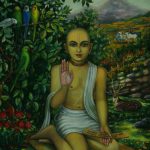
by Prem Prayojan das
In this modern era of equal rights, it was inevitable that kanistha-adhikaris would assert their inalienable right to know their svarupa.
Recently yet another article appeared from the small but vocal pro-kanistha siddha-pranali section of the Gaudiya Vaisnava community. The article entitled, “The authenticity of the concept of siddha-pranali,” by Tarun Govinda Das, attempts to spin an ongoing debate about whether siddha-pranali is an essential prerequisite for kanistha adhikaris who aspire to enter raga-marga into a debate about whether siddha-pranali has any place at all in authentic Gaudiya Vaisnavism.
The fact that siddha-pranali has a place in authentic Gaudiya Vaisnavism was never an issue. But that does not matter. The Pro-Kanistha Siddha-Pranali Campaign is not about addressing the genuine concerns of the vaisnava community. Rather, it is designed to coerce weak devotees from authentic Gaudiya lines to leave their gurus, receive a generic placebo svarupa from a babaji in a drive-by initiation, and then take up the impossible practice of mechanical visualization of asta-kaliya-lila with a rajasic and tamasic mind while imagining oneself to be already “there” in the plane of visuddha-sattva – all in the name of following the Gosvamis. Heaven help us.
We will go through the article line by line so that our respected readers can identify the misconceptions and avoid any possible confusion. For clarity, paragraphs from the article to be refuted will be introduced as “Kanistha Siddha-Pranali Campaign”. This will generally include a false “claim”, followed by their answer. In response, our refutation will be introduced simply as Gaudiya Siddhanta.
1)
Kanistha Siddha-Pranali Campaign: “CLAIM: The process of receiving siddha-pranali is not mentioned anywhere in the granthas of the six Goswamis. It is therefore inauthentic and this cheating should be stopped. ANSWER: The process of the revealing of the siddha deha (the information thereof) is not mentioned in the writings of the Six Goswamis. But most certainly the Goswamis of Vrindavana were well aware of this process.”
Gaudiya Siddhanta:
We are off to a good start here with the correct and open admission that although Srila Jiva Gosvami wrote in excess of an astonishing 400,000 verses elaborately examining all the minutiae of the subject of bhakti, neither he nor any of the other Gosvamis of Vrndavan have written anything about siddha-pranali diksa. Let that sink in for a minute.
We have to be very specific. Since the words “siddha” and “pranali” do not appear in sastra together as a coherent concept, we have to work with the conventional meaning that has arisen through colloquial usage. The term has come to refer to the “pranali” (channel) through which bhakti descends, namely the guru-parampara. In this case, “siddha” refers to the spiritual identities of the members of any particular guru-parampara. The words, “siddha-pranali” have also come to be identified with the practice of the guru verbally informing the disciple of the eleven details of his spiritual identity, known as ekadasa-bhava, as a part of the process of initiation (diksa). Herein we are concerned exclusively with the practice of siddha-pranali diksa.
Now is it inauthentic? Should this cheating be stopped? In response it must be emphasized that it is not only the position of various branches of ISKCON and the Gaudiya Math, but also the position of many babajis and gosvamis in the direct diksa lines descending from the prominent associates of Sri Caitanya Mahaprabhu, that the guru’s involvement in acquainting the disciple with his spiritual identity is completely authentic. I do not personally know anyone who questions the validity of this practice.
However, all authentic gaudiya vaisnavas firmly assert that the practice of imposing ekadasa-bhava upon kanistha-adhikaris, that is, upon neophyte devotees in the stages of sraddha, sadhu-sanga, bhajana-kriya, and anartha-nivrtti is a deception employed to attract the ignorant masses and collect disciples.
One reason being that the guru does not know in specific detail identity of the disciple until the disciple’s own ruci appears by the strength of vaisnava-seva and nama-bhajana. This has been confirmed by Srila Bhaktivinoda Thakura:
“When the spiritual master is ascertaining the aspirant’s pure personal inclinations (ruci), the aspirant should also help the spiritual master by speaking his mind about his own preferences. As long as he has not clearly established the disciple’s inclinations (ruci), the guru’s directions are not flawless.” (Srila Bhaktivinoda Thakura – Sri Hari Nama Cintamani 15.72 commentary)
Some real-life examples will help shed light on the practical reality of the issue at hand.
A few years ago, three Russian devotees in Radha Kunda became god-brothers. After initiation, they shared the “secret” details of their kanistha-siddha-pranali diksa and discovered that they all had the same svarupa, the same ekadasa-bhavas. Feeling dissatisfied that they were all the same manjari, they returned to their guru to air their doubts and voice their complaint. Their guru told them, “I have given this pranali just to give you some idea of your identity. You have to do bhajana. When your realization begins to appear we can discuss again and change it accordingly.”
In another incident, a devotee received siddha-pranali diksa from one guru in Radha-kunda. Some time later, out of curiosity, he again received siddha-pranali diksa from another guru. To his surprise, the other guru gave him a completely different identity.
Another devotee, after receiving siddha-pranali-diksa, left the path of bhakti for some years. Later she became inspired again, but she had lost her paper certificate of siddha-pranali and could not clearly remember her ekadasa-bhava. So she went back to her guru and asked to receive siddha-pranali again. To her surprise, she received a different svarupa this time, resulting in complete confusion and loss of faith.
So here we have cases of several devotees with the same svarupa, cases of devotees receiving different svarupas from different gurus, and even devotees receiving different svarupas from the same guru! Did our Six Gosvamis really want their followers to make the sampradaya into such a circus?
These cases raise another issue. Can a guru get your identity wrong? Most of the kanistha-siddha-pranali diksa-gurus believe that one’s future identity is not fixed. That makes their job easier because it is impossible for them to get it wrong. One svarupa is just as good as another. Neither the guru nor the disciple needs any qualification to randomly fabricate an identity.
If anyone who has received siddha-pranali has a doubt about the claims made herein, why do you not just ask your guru about your ekadasa-bhava again and see if he gives you the same identity? Problem solved. Alternatively, you could try going to another guru and seeing if he gives the same svarupa or not. Is it not better to know the truth than to spend your whole life in a state of self-deception?
As far as the process of siddha-pranali being inauthentic is concerned, no one has made such a claim. We only propose that the practice of giving siddha-pranali to kanistha adhikaris is a deception, though we cannot deny that it is often done with the benign intention of helping the new devotee think in terms of his relationship to the eternal reality.
In that sense, kanistha-siddha-pranali diksa is more of a placebo than a reality. It is meant to encourage the neophyte to focus on his ultimate goal and not become lost in the peripherals of bhakti. I personally know some gurus who give kanistha-siddha-pranali diksa and they have privately admitted that this is indeed their intention. But they cannot admit it to their disciples because, of course, the placebo effect would be lost. They understand that the kanistha-siddha-pranali diksa is really a generic template with a few variables just to make it look more personalized and less generic.
This perspective is not limited to the line of Srila Bhaktivinoda Thakura and Srila Bhaktisiddhanta Sarasvati. It is also commonly held amongst other vaisnava lineages. For example, Babaji Maharaja Srila Haridas Sastri in the line of Sri Gadadhara Pandita, a vaisnava scholar from a very traditional parivara, concurs:
“The original acaryas and the Gosvamis were not given siddha-pranali by anybody. Everything was revealed by the name. If we do not have faith in that, we make the Name secondary and something else prominent. Then one cannot realize the Name, form, etc., of Bhagavan. The Name itself is fully potent, and if one chants without an offensive mentality, one will realize everything, because it is Bhagavan Himself.” (Babaji Maharaja Srila Haridas Sastri – Sri Guru Darsanam pg 101)
“Theoretically such meditation exists, but the way it is practiced now is not the way it was practiced in the past. The reason is that unqualified people are misusing it. They have made a business out of it. Originally it was not given by the Gosvamis for the sake of making money or attracting followers. But now that has become the purpose. The modern gurus print it on a piece of paper and give it to the disciple at the time of initiation. That was not done before. The svarupa is something that is revealed when a person becomes qualified. “(Babaji Maharaja Srila Haridas Sastri – Sri Guru Darsanam pg 249)
“Manjari-bhava means the ultimate limit of surrender. It is another word for dasya-bhava. It is the highest level of dasya-bhava (the mood of servitorship), and Sri Krsna reveals it. No one else has the power to give you a transcendental body. Giving manjari-bhava means engaging you in Krsna’s service. There is no human being who can do that. Therefore, God Himself gives it. If a person is completely surrendered to the guru and serves him, then the guru is inspired by Krsna to reveal this fact.” “(Babaji Maharaja Srila Haridas Sastri – Sri Guru Darsanam pg 249)
“When someone has a genuine guru and is completely surrendered, which means that he does not identify with his birth, country, family, sex, and so forth, but has developed the ego of a servant of Bhagavan, at that time, Bhagavan inspires the guru to reveal this information so that the disciple can meditate in the prescribed manner.” (Babaji Maharaja Srila Haridas Sastri – Sri Guru Darsanam)
“This is all cheating. Uttama-bhakti, however, is free from all cheating. This type of procedure or practice of which you may have heard has nothing to do with the real thing. It is all cheating in the name of bhakti. One should not become influenced by it because it sounds very appealing. It is appealing because we have the experience of sex life. (Babaji Maharaja Srila Haridas Sastri – Sri Guru Darsanam)
“Instead of calling it manjari-bhava, name it asurika-bhava, because it will turn a person completely against God. If he is a sadhu to begin with, and then he is given this meditation, although he is not qualified, the practice of this meditation will naturally agitate his mind. Externally he will make a show of being a sadhu, but internally his mind will be completely full of the desire for sex. Then he has to become a hypocrite here, in the land of Sri Krsna. In the name of doing the highest sadhana, he will become a debauchee. He will be forced to engage in illicit sex life. Therefore this is asurika-bhava. Who has authorized these gurus to give this bhava to neophytes? What is their qualification? I do not know.” (Babaji Maharaja Srila Haridas Sastri – Sri Guru Darsanam)
Letter of November 1930 by Srila Bhaktisiddhanta Saraswati Thakur: ” ….By attaining anartha-nivritti, one’s svarupa is automatically awakened, and the eternal mode of thinking that is innate to it manifests. Those who profess to teach or reveal this identity are deceitful, for it cannot be done. On the other hand, if a devotee receives some inspiration after sincerely chanting for a long time, he should go to a sad-guru or an advanced devotee and ask that it be confirmed and purified by him. The svarupa has eleven aspects (ekadasa-bhava). There are many cases of unscrupulous gurus who artificially force-feed these topics to unqualified practitioners, yet that cannot be called a symptom of spiritual perfection . Those who have achieved ‘svarupa-siddhi ‘ gain such realization through internal revelation; the guru’s only involvement is to assist his disciples’ ongoing advancement. As a sadhaka progresses toward siddhi, all these things are naturally revealed within the heart that sincerely hankers for service.” (Letter of November 1930 by Srila Bhaktisiddhanta Saraswati Thakura)
To make sure time is not wasted unnecessarily in straw-man arguments, it is imperative to define the siddhanta and present the historical facts. The following conclusions are upheld by sastra and historical evidence:
1) That siddha-pranali is just one approach to raganuga-bhakti. It is not an essential or absolute prerequisite to begin raganuga-bhakti or even to progress to the higher stages of raganuga-bhakti. It is optional, since all the benefits of siddha-pranali were traditionally attained by the power of the Holy Name and the process of diksa as outlined in Sri Bhakti Sandarbha, Sri Hari Bhakti Vilasa, and Premaya Ratnavali, none of which mention siddha-pranali.
2) That nevertheless, siddha-pranali is an authentic practice coming from the line of Sri Dhyanacandra Gosvami, who was the first to mention ekadasa-bhava in his Sri Gaura Govinda Arcana-smarana Paddhati (1650 AD approx.).
3) That siddha-pranali was not practiced or taught by the Six Gosvamis. Therefore, those who have received from their Sri Guru the method followed by the Six Gosvami’s, which is perfect and complete in itself, are in no way required to receive initiation again into another method, such as that outlined by Sri Dhyanacandra Gosvami. The two methods are similar in many respects, but Sri Dhyanacandra Gosvami’s method places more emphasis on the use of many pancaratrika-mantras and rituals of arcana. Srila Bhaktivinoda Thakura has pointed to the distinction between these two approaches in Jaiva Dharma Chapter 39:
4) That siddha-pranali should never be given to kanistha-adhikaris, because
a) In all honesty, whether one considers the svarupa inherent or assigned, the guru does not know all the details of the svarupa of the neophyte disciple.
b) Sri Krsna will not reveal the disciple’s svarupa to the guru, nor will Sri Krsna inspire the guru to reveal it to the disciple before the disciple has developed mature lobha, at least in the stage of ruci. Therefore, any attempt to give siddha-pranali to a kanistha adhikari must be inspired by MAYA.
c) Siddha-pranali is detrimental for the kanistha adhikari because he is not yet established or competent in bhakti-tattva. Therefore, receiving siddha-pranali simply opens a Pandora’s box of misconceptions and leads the devotee into the swamp of practices that are incongruent with his stage of development.
Even today, all the babajis and Gosvamis in Vrndavan and Jagannatha Puri in the direct diksa lines of Sri Gadadhara Pandita, Srila Sanatana Gosvami, Sri Gopala Bhatta Gosvami, Sri Raghunatha Bhatta Gosvami, Sri Jiva Gosvami, Sri Krsnadas Kaviraja Gosvami, and many others, unanimously agree on these four conclusions.
As we have mentioned previously, the question is not “Is siddha-pranali an authentic practice?”, but rather, “Is giving siddha-pranali to kanistha-adhikaris an authentic practice? And is receiving siddha-pranali a prerequisite for raganuga-sadhana?” The answer is an emphatic “no”, in both cases. We will continue to unpack these points and address the rest of the article in question in part II. Thank you for your patience.
(To be continued)










